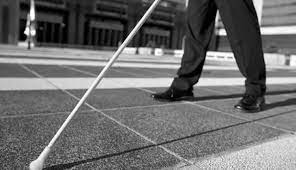October 15 is White Cane Awareness Day

The National Federation of the Blind celebrates White Cane Awareness Day each year on October 15. To blind people, the white cane is an essential tool that gives the ability to achieve a full and independent life. It allows us to move freely and safely from place to place—whether it’s at work, at school, or around our neighborhoods. White Cane Awareness Day is our way of emphasizing the critical role that this tool plays in living the lives we want and informing the public about its true significance. — NFB President Mark A. Riccobono
How to Celebrate White Cane Awareness Day
Organize an Activity or Event on White Cane Awareness Day, and throughout Blind Equality Achievement Month, members of the NFB conduct activities in their local communities such as white cane walks, film screenings and social events.
Work with your chapter or state president to get the word out about your event.
Order materials like brochures and Braille alphabet cards through the Independence Market.
Email your activity or event details to [email protected] so that we can feature them on our website. Connect with us on social media (Facebook and Twitter) using the hashtag #BlindMonth.
Encourage Local Government to Issue a Proclamation
Anyone can encourage their local government to issue a White Cane Awareness Day Proclamation. This is a great way to involve your local community and educate the public about the blind. Please print out either the White Cane Awareness Day Proclamation or the White Cane Awareness Day Proclamation and share it with your local administration.
How White Canes Work
We use our senses of hearing and touch to explore and understand the world around us. The white cane, in effect, makes our hands and arms longer, so that we can assess the situation, and move quickly and confidently. The white cane allows us to avoid obstacles, find steps and curbs, locate and step over cracks or uneven places in the sidewalk, find doorways, get into cars and buses, and much more.
What to Do When You See Someone Using a White Cane
When you see a blind person using a white cane, remember that the cane is our tool to safely and independently navigate the environment. There’s no need to shout warnings or try to physically steer us so that our canes won’t bump into things. Remember that we are using our canes to explore what is around us. If we need any help or direction, we will ask. If you are driving or cycling and see someone using a white cane, you must follow the law and stop to give that person the right of way. Here are more tips to keep in mind when meeting a blind person.
The History of White Cane Awareness Day
While it was not uncommon throughout history for blind people to use a stick or cane to navigate, society largely didn’t accept that blind people could travel by ourselves until recently. In the 1960s, the National Federation of the Blind became a leader in fighting for the rights of the blind and in pioneering innovative training programs using the white cane. At our urging, the United States Congress adopted a joint resolution in 1964 designating October 15 of each year as White Cane Safety Day and recognizing that white canes enable blind people to travel safely and independently.
While the white cane does keep blind people safe (because drivers and other pedestrians can easily see it), it is also a tool that blind people use to explore and navigate our environment. For this reason, the emphasis of White Cane Safety Day has shifted over time away from safety, and toward independence and equality. We believe that it’s important to celebrate this history and recognize the white cane as the tool that allows the blind to “come and go on [our] own” as President Lyndon Johnson said in 1964.
To emphasize the shift in focus from safety to independence, and to continue to use the white cane as a symbol, we have chosen to refer to this day as White Cane Awareness Day.




